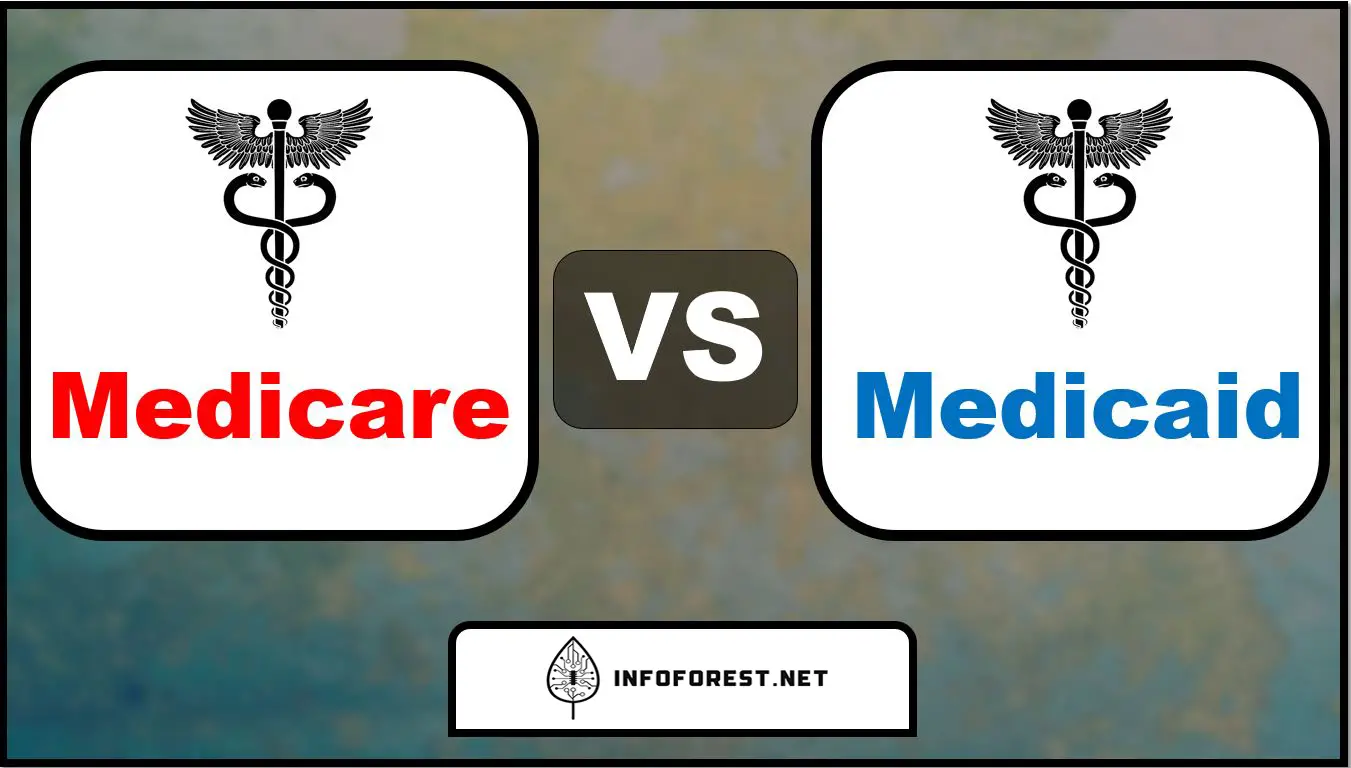
The government-sponsored Medicare and Medicaid programs help certain Americans with their health care costs. The names of this two Insurance are so similar that there is a misunderstanding about their functions and benefits.
Many elderly and disabled people receive health benefits through Medicare. The amount of income does not affect eligibility for Medicare. Medicaid is a program for low-income individuals and is often the last alternative for those who have no other options. In this article, we will analyze Medicare vs Medicaid, which is a frequently asked question for people in the United States.
Medicare
To better explain Medicare vs Medicaid, it is necessary to introduce each of these insurance plans individually and then compare them. Medicare primarily provides health insurance coverage to older people. However, younger people with certain impairments or end-stage renal failure (ESRF) may also be eligible. In 2021, approximately 64 million Americans were covered by Medicare.
Health insurance for most people in the United States depends on their employment. In the past, there weren’t many low-cost options for older people to buy their own health insurance when they retired. So in 1965, lawmakers developed Medicare to solve this problem.
Medicare Parts
- Part A (provided by the federal government): Hospitalization
- Part B (provided by the federal government): Health insurance
- Part C (provided by private insurance companies): combines Medicare parts A, B, and D with other benefits
- Part D (provided by private insurance companies): prescription drug coverage
Medicare Parts A and B are provided by the federal government, while Parts C and D are provided by private insurance companies under government oversight.
Hospital insurance under Medicare Part A and health insurance under Part B. Prescription drugs are covered under Medicare Part D, while Part C (Medicare Advantage) is a comprehensive insurance alternative that combines Medicare Parts A, B, and D with other benefits such as dental, vision, fitness, and hearing. Medicare Parts A and B are covered by default, but Part C and Part D coverage vary by plan, insurance company, and region. For the vast majority of Americans, Medicare Part A is premium-free. Premiums for Part B are usually based on the insured’s income. Medicare Part D comes in different varieties and at different prices
Medicare Phone Number
1-800-633-4227
1-800-MEDICARE (1-800-633-4227)
When should I sign up for Medicare?
You must apply for Medicare between three months before and three months after your 65th birthday. If you don’t enroll within this time period, you may experience delays and penalties that could cause you to temporarily lose your coverage.
Most Viewed Articles
Medicaid
As we mentioned before to better explain Medicare vs Medicaid, it is necessary to introduce each of these insurance plans individually and then compare them. Now it’s time to introduce Medicaid. Medicaid is a joint federal and state health insurance program created specifically for low-income Americans. To qualify for Medicaid, you must be below the federal income limit, which in states with expanded Medicaid is 138 percent of the federal poverty level.
Each year, millions of adults, children, and people with disabilities qualify for this program. As of November 2020, 72,204,587 people were covered by Medicaid, and the Children’s Health Insurance Program served 6,695,834 children (CHIP).
One of the main differences between Medicaid and Medicare are the state-specific eligibility requirements and benefits. Children from low-income families can receive health care through the Children’s Health Insurance Program (CHIP), which is part of Medicaid. In some states, this is a different program than Medicaid. In some states, the two programs are combined.
To help children in families who earn too much to be eligible for Medicaid but not enough to afford health insurance, the CHIP program was signed into law in 1997. By 2020, 9 million children were enrolled in a CHIP program. For Medicaid programs, most people don’t pay insurance premiums. Depending on the state and Medicaid plan, a co-payment may occasionally be required for appointments.
Costs
Medicaid beneficiaries are often not required to make payments, although they may be required to make a small copayment in certain circumstances. As a form of cost-sharing, states are permitted to charge minimum premiums and enrollment fees. This is relevant for certain Medicaid beneficiaries, such as:
- A household income of at least 150% of the federal poverty level, including pregnant women or young children (FPL).
- Qualified disabled individuals earn more than 150% of the federal poverty level.
- Individuals with disabilities who are employed and meet the requirements of the Ticket to Work and Work Incentives Improvement Act of 1999.
- Children with disabilities who meet the requirements of the Family Opportunity Act.
- Patients who need medical care
Medicaid benefits
Medicaid benefits vary from state to state, but the federal government mandates coverage of a number of benefits, such as:
- Nurses and midwives
- Transportation of patients to the hospital
- Early and regular preventive examinations, diagnoses, and treatments (EPSDT).
- Smoking cessation counseling for pregnant women
- Services for nursing facilities
- Laboratory and X-ray services
- Home health care services
- medical services
- services of hospitals in rural areas
- Services provided by state-approved health centers
- Services in the field of reproductive medicine
- Certified family and pediatric nurses and midwives
- Services provided in an independent birth center (if licensed or otherwise recognized by the state)
Apply for Medicaid
Medicaid eligibility is governed by state regulations in your area. Contact your state’s Medicaid office to find out if you are eligible and to begin the enrollment process. To locate an office near you and learn more about Medicaid eligibility and enrollment, visit www.medicaid.gov.
Can I Have Both Medicare and Medicaid?
Yes, some individuals are eligible for both Medicare and Medicaid. The term “dually eligible” refers to individuals who are eligible for both Medicaid and Medicare. If you are eligible and sign up for both programs, together they may cover most of your medical expenses. In addition, you may be eligible for a special category of Medicare Advantage plans known as a Dual Special Needs Plan.
Dual health plans are only for individuals covered by both Medicaid and Medicare. They fall under the category of Part C plans (Medicare Advantage), which are unique. Dual Health Plans cover hospital services, medical services, and prescription drugs. All of your Medicaid benefits remain intact. Plus, you can get additional benefits compared to Original Medicare. And it’s all at a cost of just $0.
Dual Plans For Special Needs
Dual plans for special needs are another name for dual health insurance plans. You can choose a dual health plan that best meets your needs because it is offered by private insurance companies. Your Medicaid eligibility and benefits will remain the same when you are enrolled in a dual health plan.
What is covered by Medicaid vs Medicare?
Hospitalization, doctor visits, and medical care are covered by both Medicaid and Original Medicare. However, Medicaid coverage is typically more comprehensive and includes things like prescription drugs, long-term care, and state-determined supplemental benefits such as adult dental care. In contrast, Medicare combines many components, so the private Medicare plans you purchase in addition to Original Medicare will determine your benefits.
Comparison Table for Medicare vs Medicaid
in this table, we have explained to you some of the main differences between Medicaid and Medicare health insurance. You can use this table to identify the key differences between these two insurance plans.
| Point of comparison | Medicare | Medicaid |
| Who can benefit? | Elderly people (over65)or people with disabilities | People with low income |
| What is covered by it? | Part A: Hospitalization Part B: Health insurance Part C: combines Medicare parts A, B, and D with other benefits Part D: prescription drug coverage | Hospitalization, doctor visits, and medical care , prescription drugs, long-term care, and state-determined supplemental benefits such as adult dental care |
| Costs | Depending on the plans you’ve chosen | Depending on your level of income |
| Supporter and executor | Federal government | Federal and state governments |
| Benefits | Depending on the plans you’ve chosen | Vary from state to state |
| Monthly premium | Part A: $0 part B $170.10 | Start from $0 |
Summary of Medicaid vs Medicare
In this article, we have tried to explain the controversial issue of Medicare vs. Medicaid as much as possible. In conclusion, although both Medicare and Medicaid are government health insurance plans, there are differences in covered services and cost-sharing. It is very important to know the difference between these two insurance plans and enroll in time. Otherwise, you may lose your coverage for a period of time or have to pay a fine. To learn more about Medicare and Medicaid costs and coverage, please call 1-800-MEDICARE or contact your local Medicaid office, especially if you are dually eligible.
We also invite you not to miss our other popular health articles such as Vegan vs Vegetarian, Type 1 Diabetes vs Type 2 Diabetes, and Psychologist vs Psychiatrist.






